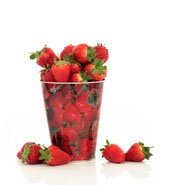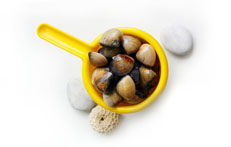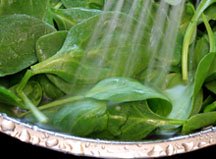FOODS HIGH IN IODINE
Foods high in iodine can help you obtain the minimum daily requirement.
If you believe you have an iodine deficiency, the amount of iodine foods should be increased to help rebuild your thyroid.
Dr. Guy Abraham point out, 12.5 mg. - 37.5 mg. in the form of Lugols' Solution is the exact range of iodine the body requires.

Iodine Absorption
There are many factors which work against us in our quest for foods high in iodine: nutritional depletion of the soil, crop land naturally deficient around the mid-west and the Great Lake region of the U.S.; and, chemical additives to our food including bromate, bromide and halogens which displace iodine in our system.
The high prevalence of sugar, refined carbohydrates and rancid vegetable oils prevent the absorption of iodine in the body.
We have all invariably ingested these toxins into our systems - knowingly or unknowingly in one way or another.
Foods High in Iodine
In order to counterbalance the lack of iodine, you can add these various foods:

- Ocean fish including shellfish, clams, lobster, sardines
- Asparagus
- Carrots
- Tomatoes
- Rhubarb
- Potatoes
- Peas
- Strawberries
- Mushrooms
- Lettuce
- Bananas
- Cabbage
- Egg yolk
- Onions
- Mozzarella cheese
- Feta Cheese
- Garlic
- Dulse
- Lima beans
- Sesame seeds
- Soybeans
- Spinach
- Summer squash
- Swiss chard
- Turnip greens
Salt Alternative
You may also supplement your diet with Season's Sea Seasonings, Organic Dulse Granules. This dried seaweed can be used as a condiment. It provides a rich source of iron, potassium, iodine, Vitamin B-6, Riboflavin, and fiber.
This product grows in coastal passages. It is certified organic by OCIA and is tested for heavy metals, herbicides, pesticides, PCB's, fuel oil and microbiological contaminants. It also comes in a liquid form.
More information on Kelp
Natural News recently posted an article about the benefits of kelp for the treatment of a goiter. This article is very informative.

Content of Iodine in Foods
These iodine rich foods have been analyzed based upon micrograms per 100 grams of food and are listed from highest amount to the lowest amount:
- Haddock, 3 oz. - 105 to 300 mcg.
- Low fat yogurt, 1 cup - 87 mcg.
- Seafood - 66 mcg.
- Trifle - 60 mcg.
- Milk 2% 1 cup - 59 mcg.
- Mayonnaise - 35 mcg.
- Vegetables - 32 mcg.
- Meat - 26 mcg.
- One Egg - 26 mcg.
- Cottage cheese 2% fat-1/2 c.- 26-71 mcg.
- Cheddar cheese, 1 oz. - 23 mcg.
- Strawberries 1 cup - 13 mcg.
- Bread (regular) 1 slice - 35 mcg.
- Gouda cheese 40 grams - 14 mcg.
- Ice cream 50 grams - 9.7 mcg.
- Ground beef, 3 oz. cooked - 8 mcg.
- Fruits - 4 mcg.
As you can see, these foods can easily be included in your diet.
Conversely, if you believe you have a pre-existing allergy to some iodine foods, you will know what to avoid. Be aware that what you believe to be an iodine allergy may be something else in disguise.
Factoid
Cod Liver Oil: Consider supplementing with cod liver oil. Dr. Price was a noted nutritionist, who advocated the use of nutrient-dense whole foods and the vital fat-soluble activators found exclusively in animal fats.
Leave Foods High in Iodine and Go to Iodine Benefits
Leave Foods High in Iodine and Return to Iodine Resource Home Page


